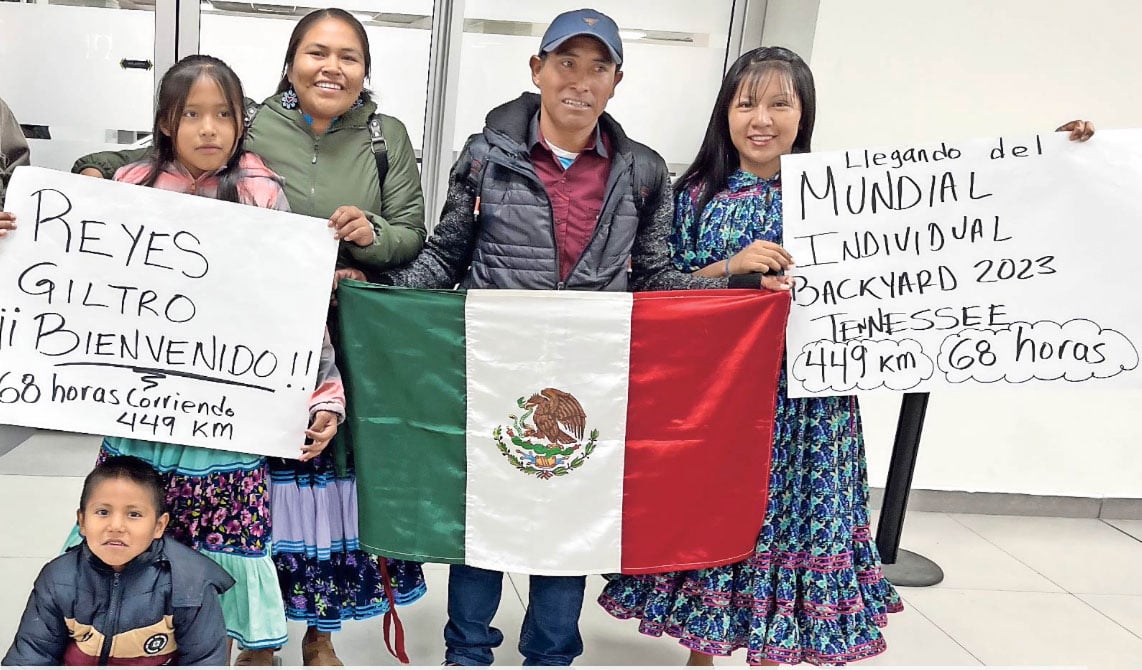Reyes Satevo ran 278 miles and was the only indigenous competitor in the Big Dog’s Backyard Ultra World Championships in Tennessee. How did he do it?
Fifteen years ago, Run—a bestselling book about indigenous Tarahumara runners in Mexico’s Copper Canyons who outran the world’s most elite endurance athletes—was published.
For a while, the public was fascinated by the Tarahumara and wanted to know their secrets: What do they eat? (Mainly corn and beans.) How do they train? (They don’t.) What shoes do they wear? (Handmade sandals made of used tire tread wrapped to their feet with goat leather.)
The book ignited a barefoot running craze in the United States, but soon the public lost interest in the impoverished goat herders who inspired it. Today, the world’s greatest runners cling to survival in their ancestral canyonlands. Narcos have cut down the Tarahumara’s sacred forests and stolen their lands. Many Tarahumara work in indentured servitude to the drug mafias; others have fled to beg on city streets in Chihuahua or Juarez.
But most Tarahumara are still on their feet in the Copper Canyons, where they live in dirt floor huts and scratch out a living as subsistence farmers. And they continue to run. For the Tarahumara, running is a team sport. They prefer to compete in traditional ball-kicking races called rarajipari. Communities organize teams of runners who kick a handmade wooden ball—sometimes for hundreds of miles. Races can last for days. Villagers place wagers and party nonstop while cheering on their runners, who carry torches as they run through the night. The race ends when one team remains. Two of the most famous Tarahumara runners—Arnulfo Quimare and Silvino Cubesare—recently competed in a head-to-head rarajipari that lasted 146 miles.
How do they do it? What is the secret to the success of the Tarahumara runners, who are often nutritionally deficient by most athletic standards? It isn’t genetic or anything special about their stride. They simply work and live harder, without the comforts that most of us take for granted. Barefoot Tarahumara children build calluses and foot strength from an early age on the rocky, rugged canyon trails. The Tarahumara rarely own vehicles, so they run or walk everywhere—often carrying water, food, and small children on their backs.
Harvard physiologist Daniel Liberman studied Tarahumara footwear, stride length, heart rate, diet, and other physiometrics for several years, and he ultimately concluded: “The Tarahumara are not great endurance runners because they have special aboriginal talents or because their biology is somehow unique. Instead, the ability to run extraordinary distances derives from hard work, physically active lifestyles, and the spiritual and social values they place on endurance running.”
Running is a central part of Tarahumara culture. Races bring together communities from remote corners of their canyonlands. Running is also a form of prayer and communion for the Tarahumara. Running grounds them and connects them to the footsteps of those who have gone before them. With every footfall, Tarahumara runners are connecting to their ancestors—and to the divine. Every stride is an expression of gratitude and grace.
Tarahumara rarely can afford to travel for races, but every now and then, a Tarahumara runner will save up enough money to run in the United States. Recently, Tarahumara runner Reyes Satevo competed in the Big Dog’s Backyard Ultra World Championships in Tennessee—a race that somewhat resembles the Tarahumara rarajipari. Racers run a 4.16-mile loop once an hour for as many consecutive hours as they can. The last person standing wins.
Satevo is a 23-year-old runner from Guachochi, near Sinforosa Canyon. He has been running most of his life and competing in races since he was 13. Satevo previously had won Mexico’s Big Backyard Ultra Championship, qualifying him for the world championships in Tennessee last fall. He took out loans from friends and family to make the trip to the States to compete.
At the world championships, Satevo completed 67 laps and an astonishing 278 miles. He ran for nearly three days without sleep. He placed fifth overall, finishing ahead of 70 sponsored athletes representing 38 countries across the globe. He was the only indigenous runner competing in the world championships. Satevo shared a few thoughts with BRO about his performance and what it meant for the Tarahumara people.
BRO: What did you think about for 278 miles?
RS: Mostly I concentrated on running. I also thought of family and friends. Sometimes, out of the blue, they would appear in my mind.
Several times, I partially fell asleep while I was running. I had dreams while I was running, and then I would hear a noise that would wake me from my dream. For a few moments, I would ask myself, “Where am I? Where am I?”
BRO: What were your favorite parts of the race?
RS: The sections of the four-mile loop that were in the forest. The smell of the forest brought me comfort.
BRO: What were the most difficult parts?
RS: I injured my knee, and it hurt on the twists and curves of the trail and downhills especially.
BRO:Why do you run?
RS: Running is always a spiritual experience for my people.
BRO: What does your performance mean for the Tarahumara people?
RS: There is a lot of hidden talent in the canyons where I live. We need more opportunities to compete. Many others want to compete, but it is difficult for us to travel far away.
I was happy to compete at a world level in a race with the top runners from other countries. I hope I represented my people and the indigenous peoples of the world well. We need more opportunities like this for indigenous people. Running provides connection to each other. It opens spaces for deeper understanding.
Thanks to Tarahumara runner and activist Irma Chavez for translating Satevo’s responses from Raramuri.
All photos courtesy of Reyes Satevo
